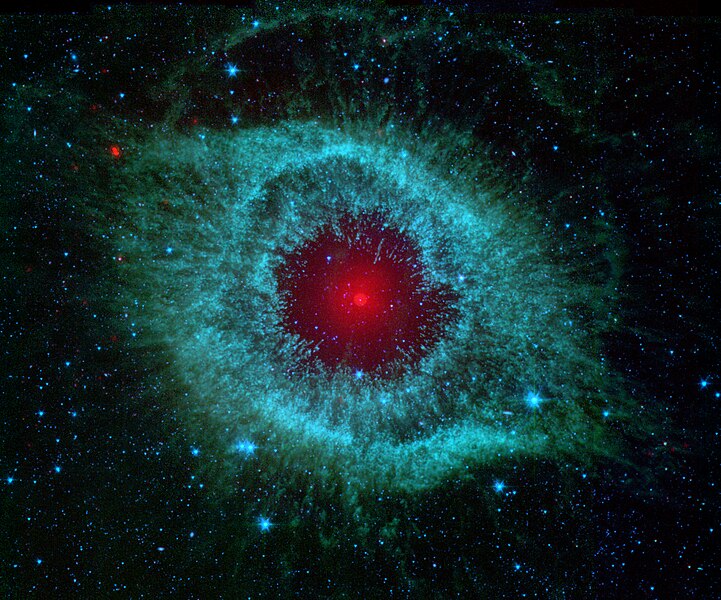Файл:Comets Kick up Dust in Helix Nebula (PIA09178).jpg
Внешний вид

Цебе хал гьабиялда бугеб гӀеблъи: 721 × 600 пикселал. Другие разрешения: 289 × 240 пикселал | 577 × 480 пикселал | 923 × 768 пикселал | 1231 × 1024 пикселал | 2462 × 2048 пикселал | 4279 × 3559 пикселал.
Аслияб файл (4279 × 3559 пкс, размер файла: 7,22 МБ, MIME-тип: image/jpeg)
Файлалъул история
Нажмите на дату/время, чтобы увидеть версию файла от того времени.
| Къо-моцӀ/мехх | Миниатура | Роценал | ГӀахьалчи | Комментарий | |
|---|---|---|---|---|---|
| гьанжесеб | 03:43, 13 фебруар 2007 |  | 4279 × 3559 (7,22 МБ) | Startaq | {{Information |Description=This infrared image from NASA's Spitzer Space Telescope shows the Helix nebula, a cosmic starlet often photographed by amateur astronomers for its vivid colors and eerie resemblance to a giant eye. The nebula, located about 700 |
Файл хӀалтӀизаби
Гьаб файл хӀалтӀизабулел гьумерал гьечӀо.
Файлалъул глобалияб хӀалтӀизаби
Гьаб файл хаду рехсарал викиязда хӀалтӀизабула:
- af.wikipedia.org-лда хӀалтӀизаби
- ar.wikipedia.org-лда хӀалтӀизаби
- arz.wikipedia.org-лда хӀалтӀизаби
- ast.wikipedia.org-лда хӀалтӀизаби
- ba.wikipedia.org-лда хӀалтӀизаби
- bg.wikipedia.org-лда хӀалтӀизаби
- bjn.wikipedia.org-лда хӀалтӀизаби
- bn.wikipedia.org-лда хӀалтӀизаби
- br.wikipedia.org-лда хӀалтӀизаби
- ca.wikipedia.org-лда хӀалтӀизаби
- cs.wikipedia.org-лда хӀалтӀизаби
- de.wikipedia.org-лда хӀалтӀизаби
- dsb.wikipedia.org-лда хӀалтӀизаби
- en.wikipedia.org-лда хӀалтӀизаби
- Helix Nebula
- Spitzer Space Telescope
- Comet nucleus
- Talk:Helix Nebula
- User:Swirlex/Userboxes
- User:Swirlex/Userboxcode
- NASA
- Wikipedia:Featured pictures/Space/Looking out
- User:Nonexyst
- User:Benjamin112
- Portal:Outer space/Selected picture
- User:Sunfishtommy/sandbox
- Wikipedia:Featured pictures thumbs/44
- Wikipedia:Featured picture candidates/October-2014
- User talk:The Herald/Archive 19
- Wikipedia:Featured picture candidates/The God's Eye
- Wikipedia:Picture of the day/October 2016
- Template:POTD/2016-10-12
- Wikipedia:Main Page history/2016 October 12
- User talk:69.50.70.9
- User:The NMI User
- User:Corinne/subpage
- User talk:The Herald/Archive 37
- Wikipedia:Userboxes/Science/Astronomy
- User:Catfurball
- User:Huggums537
Просмотреть глобальное использование этого файла.




